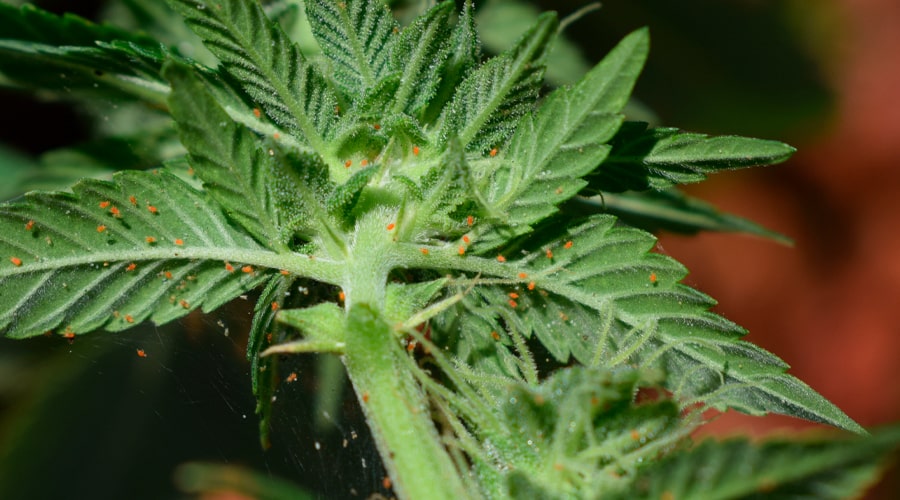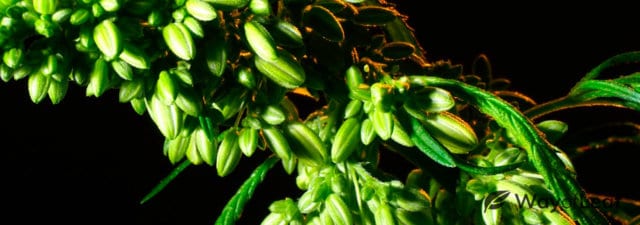Red spider mites are a cannabis crop killer if left untreated. That’s why you need to know as much as possible about this notorious pest if you want to prevent serious damage from occurring to your cannabis plants.
Therefore, the temperature that kills red spider mites is valuable information you should keep in your knowledge bank. The bad news is that this pest is tough and can generally survive temperatures as low as 32 degrees Fahrenheit. On the other hand, they can live in temperatures as high as 104 degrees Fahrenheit.
This article helps you identify these pests, explains their habitat, and outlines the environmental factors they thrive in so you can make plans to prevent infestations from occurring or spreading.
What Are Red Spider Mites?
Spider mites are part of the Tetranychidae family, and there are an estimated 1,200 species worldwide. The red spider mite (Tetranychus urticae) is one of the most common and feared among plant lovers.

Sometimes called the two-spotted spider mite, this pest likes to hide on the underside of leaves out of clear view. At 0.5mm, it isn’t the easiest thing to spot, and it damages cannabis plants by feeding on the sap.
If you don’t uncover the red spider mite early, it will continue to attack your plants, ensuring that the empty dead cells of the leaves become yellow. Issues caused by a red spider mite infestation include increased transpiration, decreased photosynthesis, and reduced plant growth.
Over time, the entire leaves of your marijuana plants will turn yellow as more cell sap gets removed. Eventually, the leaves, and perhaps the entire plant, will die.
Identifying Red Spider Mites
The red spider mite has been identified on almost 1,000 plant species worldwide. At least 150 of these plant species are considered “economically important.” As a consequence, much has been written about how to prevent them from latching onto plants, with lots of information on destroying infestations, too.
The first step is understanding what these pests look like. To give you a better idea of what to expect, let’s briefly review the life cycle of the red spider mite.
The Egg
Estimates vary, but it’s believed that female red spider mites can produce up to 150 eggs in their lifetimes at a rate of around 10 a day. What’s frightening is that, under the right conditions (usually a temperature of around 77 degrees), these eggs can grow into adult mites and lay more eggs within 10 days of hatching! This timeframe falls to seven days at a temperature of 86 degrees.
A red spider mite egg is translucent, spherical, about 0.14mm in diameter, and carries the green tinge of the leaf where it lies. As it matures, the egg becomes pale yellow. If you use a microscope, you may see the red eyespots of the embryo when the egg is close to hatching.
Immature Mites
The red spider mite’s larva is round, has three pairs of legs, and is similar in size to the egg. Apart from the red eyespots, it’s translucent, but that changes once the pest starts feeding. At this point, it becomes a straw or pale green color with black spots appearing on its back.
The newly hatched larva, known as a protonymph, has four pairs of legs and an oval shape. The spots become more apparent, as does the green coloring when the mite gets bigger. At the second stage of development, the deutonymph stage, males are smaller than females. Stage one involves active feeding. This is followed by the quiescent period, then, finally, a molt.
Fully Grown Red Spider Mites
Despite the name, the red spider mite only takes on its famous orange-red color in autumn and winter. During the rest of the year, their color can vary from brown to dark green to yellow, depending on the plant it feeds on.
Due to their small size and propensity to reside beneath marijuana leaves, you’ll generally only see them when there’s a large number present. Indeed, you may only notice their existence after spotting a cloud of dust scurrying on top of the leaves!
Female red spider mites can live for 28-30 days, whereas the males’ lifespan is much shorter at 14 days.
What Temperature(s) Kill Red Spider Mites?
Red spider mites are durable and remain a huge nuisance. Typically, they can survive at a temperature close to freezing (32 degrees Fahrenheit). As soon as the temperature drops to an uncomfortable level, this pest seeks a warmer home. They spread less quickly once the temperature falls below 50 degrees.
Furthermore, it is only at temperatures of over 104 degrees that you can expect heat stress to begin to get the better of these mites. From a cannabis growing perspective, you can’t expose your indoor grow room to such temperature extremes, as you’ll kill your marijuana plants faster than any spider mite infestation.
If that isn’t concerning enough, red spider mites thrive in a temperature range that suits your marijuana plants. Granted, the spread may slow down when temperatures fall below 86 degrees, but once this pest gets access to your plants, big trouble awaits. It’s also worth noting that the red spider mite reproduces most rapidly in the high eighties Fahrenheit.
What Other Environmental Factors Are Relevant?
Relative humidity (RH) is another big factor in red spider mite development. Opinions on this matter differ, although the consensus is that this pest dislikes high RH levels of 75% and above. The problem here is that you typically want to keep RH low when growing marijuana, especially during the blooming phase.

Another consideration is food access. Obviously, if a red spider mite infestation occurs in your cannabis grow room, they’ve hit the jackpot! When left alone, this pest can absolutely devastate your crop.
Managing Red Spider Mite Infestations
The use of pesticides is often championed as a means of combating red spider mites. The truth is that this pest can develop a tolerance to certain chemicals, making them even harder to kill.
As a marijuana grower, your first responsibility is to regularly check your crop for signs of a pest infestation. If you find that there are red spider mites on one plant, remove and destroy the affected area. Next, blast any plants that have/had mites on them with a high-pressure jet of water. This dislodges the mites and their eggs, although you should not do this with younger plants.
You can also temporarily increase the humidity in your grow room by misting your plants or watering overhead. If a plant seems overwhelmed with red spider mites, take it out of the grow room and destroy it if necessary.
Another viable option is to introduce predatory insects and mites that prey on red spider mites AND don’t cause damage to plants.
You can also spray an insecticidal soap solution on the plants. Using a neem oil solution and spraying the leaves is another way to combat red spider mites. In both instances, you need to cover the entire body of the mite for it to work. Furthermore, you’ll need to use the solution several times.
Defeating Red Spider Mites Needs a Multifaceted Solution
Unfortunately, red spider mites survive and multiply in temperatures that your marijuana plants also thrive in. While they are vulnerable in very low or very high temperatures, neither option is feasible within your marijuana grow room. This is also the case with RH.
Thus, you need to understand the life cycle of red spider mites and know the first signs of an infestation. You can help prevent them from latching onto your plants by implementing strict hygiene practices within your grow room. It’s also worth adding predatory mites that don’t harm cannabis plants to your garden as a preventative measure.
Once you see a red spider mite infestation, it’s time to act quickly. Consider briefly increasing RH in your grow room, removing any affected leaves or plants, and using organic insecticides to treat your crop. These mites damage your plants rapidly, so don’t hesitate to deal with the situation when you see them in your grow room.


![The Best Companion Plants for Your Cannabis Garden [Revealed]](https://wayofleaf.com/wp-content/uploads/2020/08/wol_the-best-companion-plants-for-your-cannabis-garden-640x225.jpg)



![8 Tips for Growing Purple Urkle [Grower’s Guide]](https://wayofleaf.com/wp-content/uploads/2019/01/wol_growing-purple-urkle-marijuana-640x225.jpg)


![8 Tips for Growing Durban Poison [Grower’s Guide]](https://wayofleaf.com/wp-content/uploads/2018/09/wol_tips-for-growing-durban-poison-640x225.jpg)


